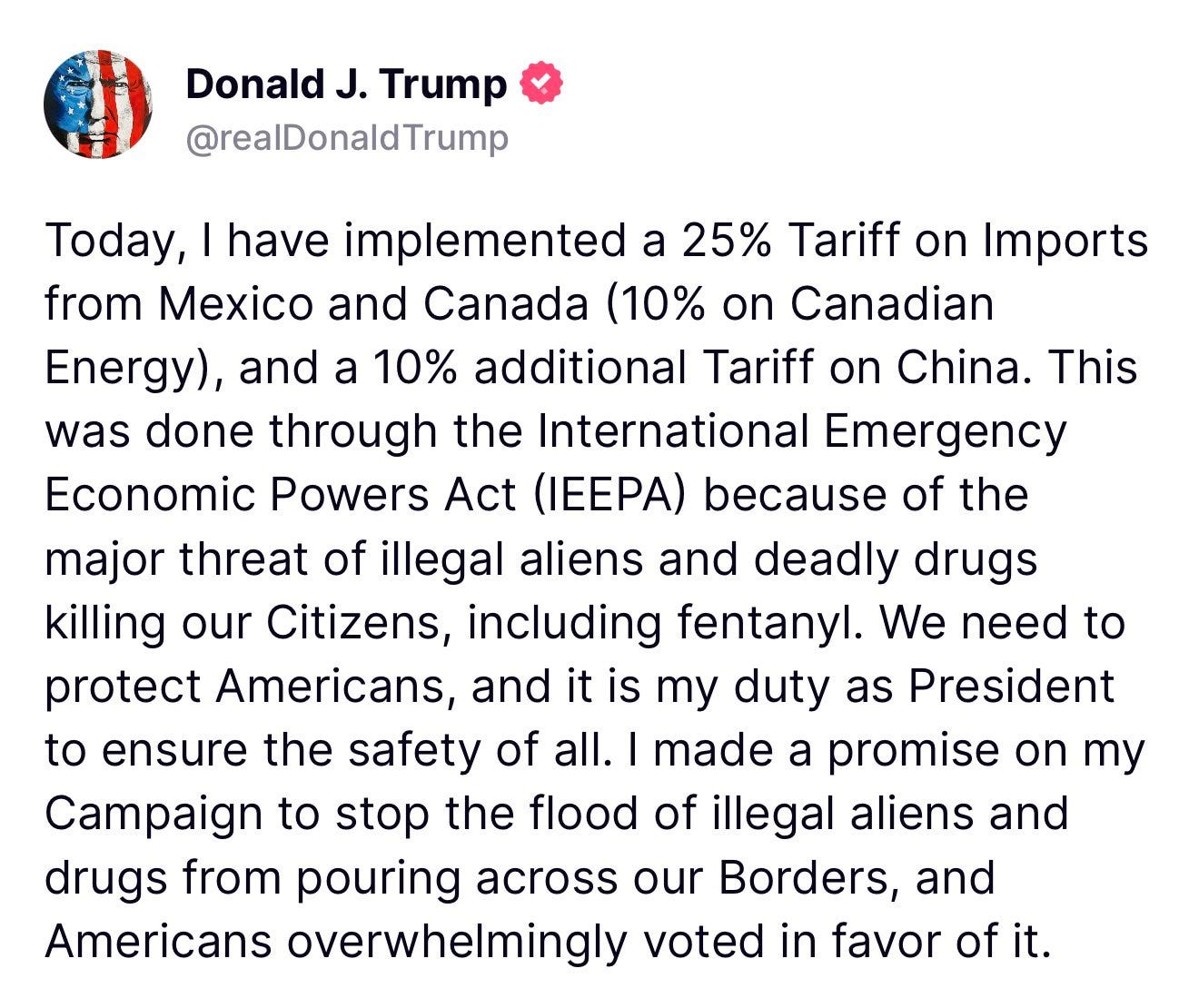Tariffs, Innovation, and America's Existential Future
Protectionism can either kill or accelerate the next industrial revolution
👋 Hello! My mission with Beyond with Yon is to ignite awareness, inspire dialogue, and drive innovation to tackle humanity's greatest existential challenges. Join me on the journey to unf**ck the future and make miracles happen.
“If we don’t make things in America, we won’t have a country.”
- President Donald Trump
America is at an inflection point.
President Trump’s new round of tariffs—25% on imports from Canada and Mexico and 10% on goods from China—is already drawing fierce debate. Some argue that it will revitalize the domestic industry and safeguard American jobs. Others warn it could increase costs, fuel inflation, and stifle trade.
However, I am interested in whether these tariffs—if used strategically—can catalyze an American industrial and technological renaissance or will be another economic roadblock raising costs without driving real innovation.
The answer depends entirely on what we do next.
The core argument for tariffs is that America has outsourced too much of its critical industry to geopolitical rivals and foreign economies. And the numbers back it up:
→ 75% of global battery production happens in China.
→ Nearly 90% of rare earth minerals essential for AI, defense tech, and clean energy are processed in China.
→ Around 80% of active pharmaceutical ingredients for generic drugs in the U.S. come from India and China.
We’ve essentially allowed ourselves to become dangerously reliant on supply chains controlled by rivals who do not have our best interests in mind.
Trump’s tariffs attempt to force a realignment of global trade by penalizing foreign dependency and incentivizing domestic production. The logic is that companies will be forced to produce in America, making importing more expensive. But that only works if we have the capability and incentive to build. And that’s where things get complicated. Tariffs alone don’t create innovation. If anything, history has shown that protectionism without investment leads to higher costs, less competition, and economic stagnation.
→ In the 1930s, the Smoot-Hawley Tariff Act raised duties on over 20,000 imported goods, triggering trade retaliation and worsening the Great Depression.
→ In the 1980s, Japan dominated U.S. semiconductor manufacturing, and tariffs imposed on Japanese chips failed to revive American leadership in the sector—because there wasn’t enough investment in R&D.
Simply raising barriers to trade doesn’t automatically make industries competitive. It has to be paired with massive investment in innovation. If the US wants to break its dependency on foreign supply chains and become a global leader in existential technologies, tariffs must be leveraged strategically. Some options to consider:
1/ Reshore critical technology manufacturing: The U.S. must control the supply chains of AI, biotech, energy, and advanced manufacturing—industries that will define the next century.
Semiconductors: The CHIPS Act allocated $52 billion to domestic semiconductor production, but tariffs on Chinese tech should be paired with even more significant R&D and talent development programs.
Biotech & Pharmaceuticals: The US must end reliance on China and India for generic drug production and vaccine manufacturing, ensuring the next pandemic doesn’t put us in a vulnerable position.
Battery & Energy Supply Chains: China dominates lithium-ion battery production, but with incentives, the US could scale domestic battery gigafactories—reducing reliance on foreign sources.
AI & Quantum Computing: The US must out-invest China in AI infrastructure—not just with talent but also with hardware like GPUs and quantum processors.
If tariffs don’t accelerate investment in AI, biotech, and energy, they will just increase costs without progress.
2/ Deploy AI and robotics to build the factories of the future: The biggest anti-tariff argument is that U.S. labor costs make domestic manufacturing too expensive. But what if we don’t need traditional labor-intensive factories? What if…
AI-driven automation can eliminate inefficiencies.
Robotics can reshore production without relying on foreign labor.
3D printing and decentralized manufacturing can scale US production.
If we pair tariffs with AI-powered industrial reinvention, we can outcompete foreign supply chains instead of just taxing them.
3/ Align tariffs with a national tech strategy: Protectionism only works if it’s part of a larger strategy. For the US to lead the world in existential innovation, then tariffs should be part of a broader plan that includes:
Massive R&D funding in AI, biotech, and nuclear energy
Public-private partnerships for tech infrastructure
Education reform to grow next-gen engineers, AI researchers, and quantum scientists
Without these, tariffs are just taxes that hurt businesses without creating alternatives.
The bottom line is that tariffs alone won’t save the US, and innovation will.
President Trump’s tariffs are neither the solution nor the problem. They are a tool—one that can either accelerate American industrial dominance or cripple the economy with higher costs. We should use this moment to invest in next-gen industries and enable America to lead the future. If we rely on tariffs alone, we’ll likely fall behind.
The US must think bigger and ensure American technological superiority. We have the resources, talent, and capital.
The main question is, do we have the vision?
Thanks for reading,
Yon
Connect with me on Linkedin and X.
AI assistants were used to help research and edit this essay.



